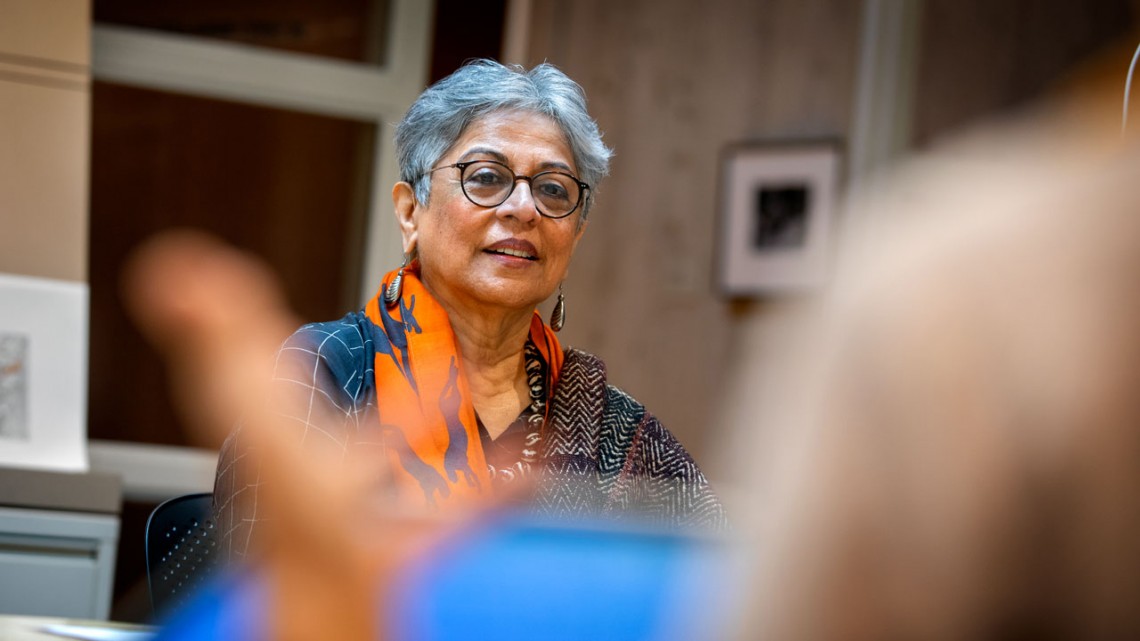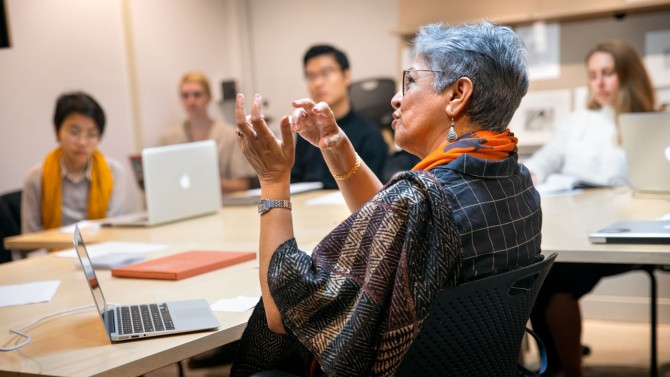
Indian architect and educator Brinda Somaya speaks on campus as an A.D. White Professor-at-Large.
Architect Somaya bridges historic, modern concerns in restoration work
By Daniel Aloi
Indian architect Brinda Somaya, on campus Oct. 21-27 as an A.D. White Professor-at-Large, is a conservationist balancing respect for heritage with functional modern needs. She has done extensive work amid the built environment of Mumbai, which has seen a transformation over 70 years of Indian independence and her four decades of practice.
“It has changed from a city with beautiful villas to the huge modern city we know today,” Somaya said in her public lecture Oct. 23 in Klarman Hall. The architect, planner, educator, preservationist and community activist discussed projects featured in her new monograph, “Works and Continuities.”
Somaya is the principal architect and managing director of Somaya and Kalappa Consultants (SNK), a firm she founded in her garden shed in Mumbai in 1978.
SNK was chosen in an international competition as the lead restoration architect on the Indian Institute of Management, a 60-acre business school campus in Ahmedabad designed by Louis Kahn, who died in 1974, before the project was finished. It includes a library and residential buildings.
Kahn’s modernist exposed-brick buildings have geometric openings and other features referencing traditional Indian architecture. Somaya noted Kahn’s observation that “‘the school and the dormitories are a unit, like a monastery.’”
The firm has completed work on the institute’s library, “one of the first buildings of the 20th century to be restored in India,” she said. The restoration involved research in Kahn’s native Philadelphia on the original construction that began in the 1960s. SNK’s work included adding air conditioning and attention to lighting and finishing details, she said.
“I hope the students love it. What they need from a library is not what it was when Kahn built it,” Somaya said.
In a heritage building restoration, she said, “what’s really important is how it is used.” Her practice is marked by conservation of materials and resources, and a participatory design ethos considering local and cultural contexts.
The Banyan Park campus of Tata Consultancy Services (TCS) in suburban Mumbai, an information technology and software development business in a natural setting, posed challenge and opportunity, she said. The project won SNK the Indian Heritage Society’s 2007 Urban Heritage Award.
Somaya’s firm restored traditional colonial-era bungalows and art deco buildings on the site, and updated them with high-technology details and modern interior design. The nine-month project included newly commissioned artwork and displays of historical material, on India’s post-independence and industrial growth, in the corporate headquarters building.
“Working with local craftsmen, we designed an art center within the building itself, and worked the three floors around themes of metamorphosis, reflection and evolution. It’s a complete change in thinking in India to how even old corporate groups want to work,” she said of the design, which includes “an art-filled lounge where even the chairman comes to sit.” (TCS is part of the Tata Group, a conglomerate chaired from 1991 to 2012 by Ratan Tata ’59, B.Arch. ’62.)
Other projects she discussed included the restoration of an 18th-century landmark, Mumbai’s St. Thomas Cathedral, for which SNK won UNESCO’s Asia-Pacific Award in 2004, and “India and the World,” an exhibition she designed in Mumbai in collaboration with a British Museum curator.
“There’s a conversation between the objects throughout the exhibition, as we showed how different cultures fought for their independence over time,” she said.
During her campus visit, Somaya also critiqued the work of students in an architecture studio class, taught by Lily Chi and Sarosh Anklesaria, that recently returned from Ahmedabad. And she lectured an architecture class on her restoration of the Kahn Library, and led a workshop on exhibition design for students in a graduate seminar who are curating and designing an upcoming exhibit at the Herbert F. Johnson Museum of Art with objects from the museum’s collection.
Somaya is a distinguished professor at the Indian Education Society’s College of Architecture in Mumbai and has been an influence on architectural education and practice in emerging countries. She also is a founder and trustee of the HECAR Foundation, dedicated to history, education, conservation, architecture and research.
Somaya and professor of architecture Mary Woods, a contributor and editorial adviser to Somaya’s book, will be featured in conversation at a book launch event Nov. 5 at AAP NYC, including a reception and book signing, and an exhibition designed by Somaya of various projects featured in “Works and Continuities.”
The conversation will be livestreamed. The event also celebrates the new softcover edition of Woods’ book, “Women Architects in India: Histories of Practice in Mumbai and Delhi,” spanning the 1930s to the present day.
Media Contact
Get Cornell news delivered right to your inbox.
Subscribe
